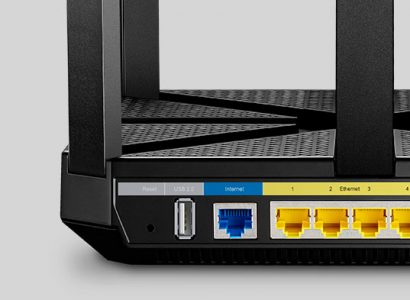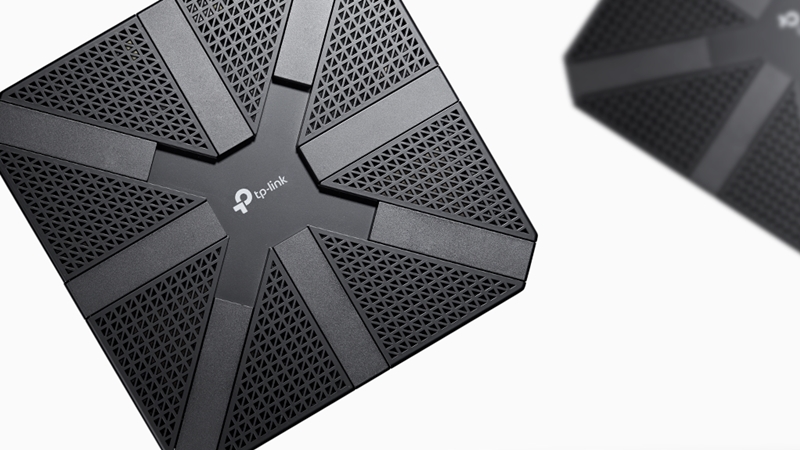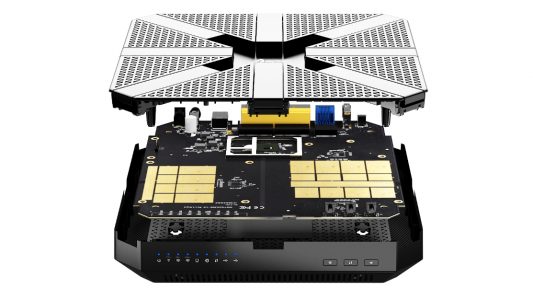In our on-going quest to rid the world of terrible WiFi, the TP-Link Archer AC5400 router landed on our doorstep a few weeks ago.
The AC5400 (as we will be referring to it moving forward) is a big router that has three seperate WiFi bands, beamforming and various other technological goodies that are designed to rid your home of terrible WiFi.
We’ve been using the router for two weeks now and while we are impressed the biggest question we needed to answer was whether the AC5400 was good enough to justify it’s R5 799 price tag. The short answer is yes but it really depends on your use case.
Close encounters of the tri-band kind
The AC5400 is a big bulky router that looks like TP-Link took design inspiration from Stonehenge when its eight (yes eight) antenna are extended.
To give you a sense of how big this router is, it’s almost as large as my PS4 console and it even has its own power brick.
If you want a dainty router that will fit in with your interior decorating this is not it, unless you’re going for a gothic aesthetic with blue lighting, then the AC5400 is perfectly suited for that look.
The bulk is not unwarranted though. Inside the router is a 1.4GHz dual core CPU and three co-processors.
Confused as to why a router requires three processors we dove a bit deeper into the AC5400.
As it turns out each co-processor helps optimise a particular WiFi band the router operates on while the main processor insures things remain stable no matter which band you are connected through.
The availability of three different bands for users to connect to is great. When playing a game of Hearthstone on my handset in the evenings when most folks are home and clogging up the 2.4GHz band I often switch to one of the 5GHz bands.
The freedom this allows for is rather great I must say. Being able to reserve one 5GHz band for things like Netflix streaming or – in my case – work is wonderful and should insure that lag becomes a thing of the past. So long as your internet connection is working.
Does it work?
Of course a WiFi router is only as good as its performance and the AC5400 makes some bold claims about what it is capable of.
So in my old house with walls as thick as I am here is what we experienced with regards internet speeds.
| Distance | Download/Upload | Packet loss | Ping |
| 0m | 4.18Mbps / 1.26Mbps | 0% | 29ms |
| 10m | 4.94Mbps / 1.47Mbps | 0% | 29ms |
| 20m | 4.99Mbps / 1.48Mbps | 0% | 35ms |
As you can see TP-Link’s beamforming, high power amplifiers and NitroQAM are doing their job giving us the same performance no matter how far we are from the router. Things do start giving in at around the 35 – 40m mark though so take that into account if your home/office is larger.
Testing transfer speeds is a bit of a tricky situation as I don’t own two devices which support 5GHz bands. Transferring a file from from a hard drive connected to the router we transferred a 4.2GB video file in just over 15 minutes over the 2.4GHz band.
The take away from this testing is that the AC5400 is stable and – as it claims on the box – it will spread WiFi to every corner of your home without breaking a sweat.

The one downside of this router is that your neighbours will be able to see your WiFi network and connect to it, if they can guess the password that is.
The setup
As with most routers these days everything can be done via an app for Android or iOS called Tether.
Tether is really simple to use and even once I’d gone through the painless setup process I found myself logging into the app daily just to play with settings.
Everything can be done from Tether including setting up network names and passwords, creating a guest network and even managing parental controls.
One night as the router was glaring at me with its blue LEDs I opened the app to engage night mode which turns the LEDs off. All done from my phone. Lazy? Perhaps, but the Tether app made me do it.
Conclusion
At the end of the day the only question left to answer is whether the TP-Link Archer AC5400 is worth the R5000+ you need to fork out to get your own.
To answer that you should say yes to the following questions:
- Do you have a fibre internet connection?
- Are you still using the router your ISP bundled with your internet package?
- Do you struggle to get WiFi in every corner of your home/office?
- Is having WiFi in every corner of your home/office vital?
If you answered yes to all of those questions and you can’t be bothered to install WiFi extenders at strategic points throughout your house/office then yes the AC5400 is worth considering and it will give you the best WiFi experience you can possibly imagine.
For the average home user however, the AC5400 is a bit overkill but even then, if you think it’s time to upgrade your home or office WiFi situation, TP-Link’s AC5400 is worth considering.
Disclaimer: The TP-Link Archer AC5400 was sent to htxt.africa for review by TP-Link South Africa. This review was not paid for and the review unit will be returned to TP-Link.
[su_box title=”TP-Link Archer AC5400 specifications” box_color=”#f37021″]
Standard 802.11 a/b/g/n/ac
Frequency 2.4GHz and 5GHz x 2
Max data rate 1 000Mbps (2.4GHz) 2 167Mbps (5GHz)
Interface 1 x Gigabit WAN port, 4 x Gigabit LAN port, USB 3.0 x 1, USB 2.0 x 1, Tether app
Price R5 799
[/su_box]


